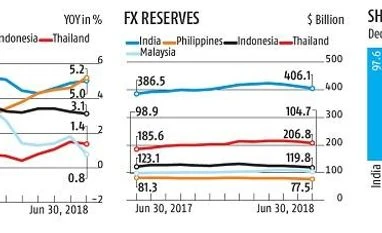Such competition can ruin relatively weak countries, as a weak currency means higher import costs. Debt servicing abilities of devaluing countries also get hampered with a weak currency.
In this scenario, pundits say Asian currencies would be the worst hit, as any disturbance would lead to an outflow of foreign money from the countries. India has seen its fair share of such outflows, and its currency has also come under immense pressure recently, falling to its lifetime low of 69.10 against the dollar, about a month back.
However, on the face of it, it seems that India is still better off than many others. First, foreign access to India’s debt, at less than 6 per cent of the outstanding stock, is lower than many Asian tigers. Second, India’s foreign exchange reserves at $400 billion-plus still give the RBI to stave off pressure on its currency for some time.
Third, India’s political economy seems to be stable after the Opposition was defeated in the no-confidence motion brought against the central government. India’s inflation is well-anchored, thanks to an inflation-targeting central bank. So, in the case of a currency war, India would be pulled down like others, but the fall would be cushioned.
To read the full story, Subscribe Now at just Rs 249 a month
Already a subscriber? Log in
Subscribe To BS Premium
₹249
Renews automatically
₹1699₹1999
Opt for auto renewal and save Rs. 300 Renews automatically
₹1999
What you get on BS Premium?
-
Unlock 30+ premium stories daily hand-picked by our editors, across devices on browser and app.
-
Pick your 5 favourite companies, get a daily email with all news updates on them.
Full access to our intuitive epaper - clip, save, share articles from any device; newspaper archives from 2006.
Preferential invites to Business Standard events.
Curated newsletters on markets, personal finance, policy & politics, start-ups, technology, and more.
Need More Information - write to us at assist@bsmail.in
)